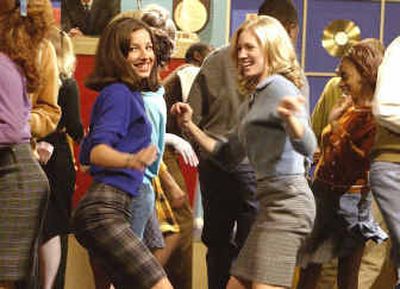‘Dreams’ moves to Wednesday

A couple of years ago during an interview with NBC boss Jeff Zucker, I asked him if he feared his tombstone would read: “Here lies Jeff Zucker, the man who gave us desperate contestants eating horse rectums on television.”
He rolled his eyes.
“Yeah, yeah,” Zucker replied. “I’m the guy who put on ‘Fear Factor.’ But I’m also the guy who put on ‘American Dreams’ and the guy who put on ‘Boomtown.’ “
Well, “Boomtown” – an innovative cop drama that sometimes told its stories from end to beginning – was canceled in December 2003.
And now “American Dreams” may be about to join it in the TV trash bin.
After benching the show during the February sweeps, NBC first chopped its season from 19 episodes to 17, then rescheduled it from Sunday night to Wednesday, where it will be up against ABC’s ratings powerhouse “Lost.”
“We’re a show on the bubble,” agrees “American Dreams” creator Jonathan Prince. “If you like ‘American Dreams,’ this is the time to say so. This is the time when it would help.”
If ever a TV show deserved help, it’s “American Dreams.” The story of a pair of middle-class families (one white, one black) in 1960s Philadelphia has an ensemble cast the equal of any on television; a writing staff that’s both thoughtful and witty; and the boppingest rock ‘n’ roll soundtrack ever assembled, period.
(Anybody can put together oldies-radio standards like “Baby Love” and “California Girls,” but where else are you going to find buried ‘60s treasures like “Concrete and Clay” or “Grim Reaper of Love”?)
And with its unstinting look at the 1960s, it’s one of just a handful of shows in the whole history of television that helps us understand who we are and where we came from, how we became the America of today.
Regardless of what you think of the ‘60s, whether you view them as the beginning of a brave new world of social justice or an orgy of juvenile self-indulgence, they were a historical hurricane that remapped American society. The cultural and political fractures of the decade – the civil rights movements, feminism, drugs, the sexual revolution, the role of U.S. troops in policing the world – are still registering aftershocks 40 years later.
“American Dreams” allows us to examine those issues both from the distance of four decades, and through the eyes of the people living through them. It makes them more comprehensible – and yet, paradoxically, emphasizes their complexity – by reducing them to bite-sized chunks.
When her brother J.J. is shipped off to Vietnam, 17-year-old Meg Pryor becomes an anti-war activist – but discovers to her shock that J.J. regards her efforts as disloyal rather than supportive.
Her black school chum Sam Walker is frustrated that their interracial friendship runs into as much resistance from his family as hers. When Meg’s mother decides to take a job outside their home for the first time, her children disapprove at least as much as her husband.
In homes all over America, parents watch the show with teenage children who are getting an unprecedented (and, occasionally, uncomfortable) glimpse into the warts-and-all world from which Mom and Dad came.
It’s true the “American Dreams” weekly audience is an unspectacular 7.6 million – and in the crucial 18-to-49 age group, an even less spectacular 3.3 million. (Compare that to the same numbers for the show’s new head-to-head competitor “Lost”: 16.3 million total viewers and 7.8 million 18 to 49.)
But it’s also true that few shows on TV deliver as much bang for the buck to advertisers looking for upscale, educated viewers. “American Dreams” is in TV’s top 20 in terms of its percentage of college-educated viewers, and No. 9 in the percentage of viewers aged 25-to-54 who make more than $110,000 a year.
In TV Week magazine’s annual poll of critics, conducted in January, “American Dreams” was named the 15th best show on television – better than NBC’s graying “West Wing,” better than its prized sitcom “Scrubs,” better than any other show on the network.
Mary Potter, a 20-year-old sophomore at Delaware County Community College in Media, Pa., has collected more than 7,000 signatures so far on her Internet petition to save the series. (You can find it at www.petitiononline.com/SaveAD/ petition.html; another online effort is under way at www.save-americandreams.com.)
” ‘American Dreams’ is a family drama, but it’s not a nerdy-nerd show,” Potter says. “So much on TV today is a reality show, and if it’s not that, it’s medical or murder.
“This is such an original show. There’s not anything nearly like it.”